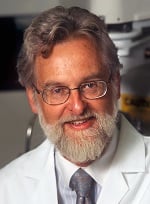 |
| UVA's John Herr |
John Herr's lab at the University of Virginia made the cover of the scientific journal Biology of Reproduction with new work on finding a male contraceptive.
The research team zeroed in on the array of molecular changes which occur as sperm fuses with an egg. And they observed that one key protein, ESP1, plays an essential role in stabilizing the sperm head, allowing it to penetrate the egg. That's a particularly critical role, as sperm undergoes some dramatic changes during the fertilization process.
"We suspect ESP1 is one of the key molecules that helps to stabilize the equatorial segment region of the sperm head," Herr said.
"Getting at the molecular components of the fertilization event has a lot of practical applications--as well as intellectual value--because you want to account for all the major components involved in the essential events of the fertilization cascade," explained Herr, a cell biologist. "You want to know which molecules are located precisely where, and when, as the sperm head becomes remodeled prior to fertilization. Just getting all the molecules defined and dissected and located in their correct subcellular positions is a major challenge, and this report adds to that fund of knowledge."
ESP1 is also evidently important in the development of sperm.
The next step in the lab's work will be to explore the interactions that occur between the ESP1 protein and sugar molecules as the team explores ways to safely disrupt the process, pointing the way to a possible male contraceptive. It's early days in this research effort. And, of course, any drug that would be intended for use by millions of men would require a huge clinical development effort. But the market potential could also drive significant interest from Big Pharma.
- here's the release
- read the research article